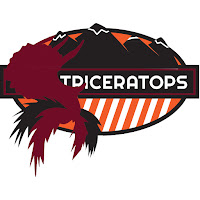Tyrannosaurus Rex
_________________________________________________________________________________
Type of dinosaur species: Rex
Length: 40 ft.
Weight: 6-7 tons
Location: North America
Time: 67-65 million years ago, Late Cretaceous
Food: Carnivore; other dinosaurs
Environment: Inland, costal, tropical, and semi-arid plains
Interesting Facts:
- Scientists theorize that the T. Rex was not a hunter, but rather a scavenger. This is an ongoing debate between scientists. Supporting this theory are the facts that they have not found any healed bit marks from the T. Rex on other dinosaurs, the t-rex's small arms would have been useless to hold down prey, and the dinosaur itself did not move quickly.
- More than 50 T. Rex skeletons have been found to date.
- Tyrannosaurus Rex means "tyrant lizard king".
- The T. rex was one of the last dinosaurs left before the mass extinction event.
Sketches
_________________________________________________________________________________

Top 3 Illustrator Logos
_________________________________________________________________________________



1. The comet seen in this logo is due to the fact that the T. Rex was one of the last dinosaurs left before the mass extinction event. Both in our popular culture and due to scientific fact, the T. Rex is the king of the dinosaurs. The three protrusions from the comet represent a crown only fitting for the "tyrant lizard king". The dinosaur's footprint, represented in the center of the comet, is also an iconic representation of the dinosaur. The alarming red color was chosen to represent the dangerous threat the dinosaur posed to others living creatures around it, although it is unclear weather this dinosaur was a scavenger or a hunter. Either way, this dinosaur probably made a bloody mess every meal time. The type, "Stencil Std Bold", is bold, heavy, and matter-of-fact, just like the 40 ft. long, 6 ton dinosaur's stature and the perception of the dinosaur.
2. The large "T" emphasized that our culture has abbreviated the Tyrannosaurus Rex to T. Rex. The contracting sizes of the "T" to "Rex" represents the size ratio between the T. Rex's head and body to its tiny arms. The contracting sizes of the "T" to "Rex" also represents how this dinosaur towered over and outweighed the other dinosaurs and creatures present in it's time period. The alarming red color was chosen to represent the dangerous threat the dinosaur posed to others living creatures around it, although it is unclear weather this dinosaur was a scavenger or a hunter. Either way, this dinosaur probably made a bloody mess every meal time. I used the type "Tw Cen MT" for this logo because it is uniformly geometric and heavy.
3. The teeth of the T. Rex were around 1 ft. long, which is the largest tooth yet found of any carnivorous dinosaur. They were like dangerous spikes because they did not have serrated edges. This logo plays off the nature of the T. Rex's teeth and the fact that the massive bite had the power to crush bone (evidenced by bones found in the stomach remains of a T. Rex). The hazardous angles and the alarming red color were chosen to represent the dangerous threat the dinosaur posed to others living creatures around it, although it is unclear weather this dinosaur was a scavenger or a hunter.
Final Logo
_________________________________________________________________________________
I chose to use this logo because it best conveys the nature of the T. Rex, popular cultures opinion of the dinosaur, and distinguishing facts about the dinosaur.
Sources
_________________________________________________________________________________
Smith, Dave. "The Tyrant Lizards:The Tyrannosauridae." The Tyrannosauridae. Berkley, 11 Nov. 1995. Web. 26 Apr. 2016. <http://www.ucmp.berkeley.edu/diapsids/saurischia/tyrannosauridae.html>.
"The Dino Directory - Tyrannosaurus - Natural History Museum." The Dino Directory - Tyrannosaurus - Natural History Museum. The Natural History Museum, n.d. Web. 26 Apr. 2016. <http://www.nhm.ac.uk/discover/dino-directory/tyrannosaurus.html>.
"Tyrannosaurus Rex, Dinosaur Pictures, Dinosaur Facts - National Geographic." National Geographic. National Geographic, n.d. Web. 26 Apr. 2016. <http://animals.nationalgeographic.com/animals/prehistoric/tyrannosaurus-rex/>.














































